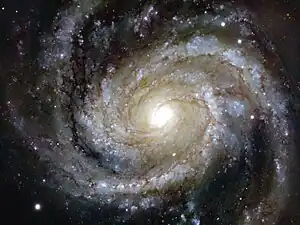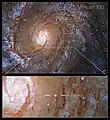Messier 100
Messier 100 (also known as NGC 4321) is a grand design intermediate spiral galaxy in the southern part of the mildly northern Coma Berenices.[5] It is one of the brightest and largest galaxies in the Virgo Cluster and is approximately 55 million light-years[3] from our galaxy, its diameter being 107,000 light years, and being about 60% as large. It was discovered by Pierre Méchain in 1781[lower-alpha 1] and 29 days later seen again and entered by Charles Messier in his catalogue "of nebulae and star clusters".[6][7]. It was one of the first spiral galaxies to be discovered,[7] and was listed as one of fourteen spiral nebulae by Lord William Parsons of Rosse in 1850. NGC 4323 and NGC 4328 are satellite galaxies of M100; the former is connected with it by a bridge of luminous matter.[8][9]
| Messier 100 | |
|---|---|
 Galaxy Messier 100 by ESO revealing complex spiral arm structure | |
| Observation data (J2000 epoch) | |
| Constellation | Coma Berenices[1] |
| Right ascension | 12h 22m 54.9s[2] |
| Declination | +15° 49′ 21″[2] |
| Redshift | 1571 ± 1 km/s[2] |
| Distance | 55 Mly[3] |
| Group or cluster | Virgo Cluster |
| Apparent magnitude (V) | 9.3[4] |
| Characteristics | |
| Type | SAB(s)bc[2] |
| Size | 107,000 ly (diameter) |
| Apparent size (V) | 7′.4 × 6′.3[2] |
| Other designations | |
| NGC 4321 | |
Early observations
After the discovery of M100 by Méchain, Charles Messier made observations of the galaxy depicting it as a nebula without a star. He pointed out that it was difficult[7] to recognize the nebula because of its faintness. William Herschel was able to identify a bright cluster of stars[7] within the "nebula" during his observations. His son John expanded the findings in 1833. With the advent of better telescopes, John Herschel was able to see a round, brighter galaxy; however, he also mentioned that it was barely visible through clouds. William Henry Smyth[7] extended the studies of M100, detailing it as a pearly white nebula and pointing out diffuse spots.
Star formation
Messier 100 is considered a starburst galaxy[10] with the strongest star formation activity concentrated in its center, within a ring – actually two tightly wound spiral arms attached to a small nuclear bar of radius: one thousand parsecs[11] – where star formation has been taking place for at least 500 million years in separate bursts.[12]
As usual on spiral galaxies of the Virgo Cluster, in the rest of the disk both star formation[13] and neutral hydrogen, of which M100 is deficient compared to isolated spiral galaxies of similar Hubble type,[14] are truncated within the galaxy's disk, which is caused by interactions with the intracluster medium of Virgo.
Supernovae
Seven supernovae have been identified in M100.[5]
- In March 1901 the first was found, SN 1901B,[5][15] a type I supernova found with a magnitude of 15.6 at 110"W and 4"N from its nucleus.
- SN 1914A[5][16] was then discovered in February to March 1914; its type was undeterminable but was found with a magnitude of 15.7 at 24"E and 111"S from its nucleus.
- Galactic observation from early to mid 1960[lower-alpha 2] found SN 1959E, another type I supernova,[5][17] with the faintest magnitude, 17.5, among the five found, at 58"E and 21"S from its nucleus.
- On April 15, 1979, the first type II supernova found in the M100 galaxy was discovered; however the star SN 1979C[5][18] faded quickly; later observations from x-ray to radio wavelengths revealed its remnant.
- The fifth supernova was discovered February 7, 2006; the star SN 2006X[5][19] had a magnitude of 15.3 when discovered two weeks before fading to magnitude +17.
- Supernova SN 2019ehk, discovered on April 29, 2019, reached a peak magnitude of approximately 15.8.
- The seventh supernova, SN 2020oi, was discovered on January 7, 2020. It was a type Ic supernova, which reached a peak magnitude of 17.7.[5][20]
Gallery
 Image of Messier 100 taken by the NASA/ESA Hubble Space Telescope
Image of Messier 100 taken by the NASA/ESA Hubble Space Telescope Messier 100 Hubble images centered on supernova SN 2019ehk
Messier 100 Hubble images centered on supernova SN 2019ehk
See also
References and footnotes
- R. W. Sinnott, ed. (1988). The Complete New General Catalogue and Index Catalogue of Nebulae and Star Clusters by J. L. E. Dreyer. Sky Publishing Corporation/Cambridge University Press. ISBN 978-0-933346-51-2.
- "NASA/IPAC Extragalactic Database". Results for NGC 4321. Retrieved 2006-08-31.
- "Messier 100". Hearst Observatory. Retrieved 2010-02-23.
- "Messier 100". SEDS Messier Catalog. Retrieved 30 April 2022.
- "Messier 100". SEDS: Spiral Galaxy M100 (NGC 4321), type Sc, in Coma Berenices. Retrieved 2010-02-23.
- "Catalog of Nebulae and Star Clusters". SEDS. Retrieved 2010-02-23.
- "Messier 100". SEDS: Observations and Descriptions. Retrieved 2010-02-23.
- S. di Serego Alighieri; et al. (2007). "The HI content of Early-Type Galaxies from the ALFALFA survey I. Catalogued HI sources in the Virgo cluster". Astronomy and Astrophysics. 474 (3): 851–855. arXiv:0709.2096. Bibcode:2007A&A...474..851D. doi:10.1051/0004-6361:20078205. S2CID 5332365.
- "NGC 4323". SIMBAD. Centre de données astronomiques de Strasbourg. Retrieved 2010-02-23.
- Wozniak, H.; Friedli, D.; Martinet, L.; Pfenniger, D. (1999). "Double-barred starburst galaxies viewed by ISOCAM". The Universe as Seen by ISO. 427: 989. Bibcode:1999ESASP.427..989W.
- Sakamoto, Kazushi; Okumura, Sachiko; Minezaki, Takeo; Kobayashi, Yukiyasu; et al. (1995). "Bar-Driven Gas Structure and Star Formation in the Center of M100". The Astronomical Journal. 110 (3): 2075. Bibcode:1995AJ....110.2075S. doi:10.1086/117670.
- Allard, E. L.; Knapen, J. H.; Peletier, R. F.; Sarzi, M. (2006). "The star formation history and evolution of the circumnuclear region of M100". Monthly Notices of the Royal Astronomical Society. 371 (3): 1087–1105. arXiv:astro-ph/0606490. Bibcode:2006MNRAS.371.1087A. doi:10.1111/j.1365-2966.2006.10751.x. S2CID 119370091.
- R. A. Koopmann; J. D. P. Kenney (2004). "Hα Morphologies and Environmental Effects in Virgo Cluster Spiral Galaxies". Astrophysical Journal. 613 (2): 866–885. arXiv:astro-ph/0406243. Bibcode:2004ApJ...613..866K. doi:10.1086/423191. S2CID 17519217.
- Chung, A.; Van Gorkom, J.H.; Kenney, J.F.P.; Crowl, Hugh; et al. (2009). "VLA Imaging of Virgo Spirals in Atomic Gas (VIVA). I. The Atlas and the H I Properties". The Astronomical Journal. 138 (6): 1741–1816. Bibcode:2009AJ....138.1741C. doi:10.1088/0004-6256/138/6/1741.
- "SN 1901B". SIMBAD. Centre de données astronomiques de Strasbourg. Retrieved 2010-02-23.
- "SN 1914A". SIMBAD. Centre de données astronomiques de Strasbourg. Retrieved 2010-02-23.
- "SN 1959E". SIMBAD. Centre de données astronomiques de Strasbourg. Retrieved 2010-02-23.
- "SN 1979C". SIMBAD. Centre de données astronomiques de Strasbourg. Retrieved 2010-02-23.
- "SN 2006X". SIMBAD. Centre de données astronomiques de Strasbourg. Retrieved 2010-02-23.
- "SN 2020oi". SIMBAD. Centre de données astronomiques de Strasbourg. Retrieved 2010-02-23.
- On March 15
- February 21 to June 17
